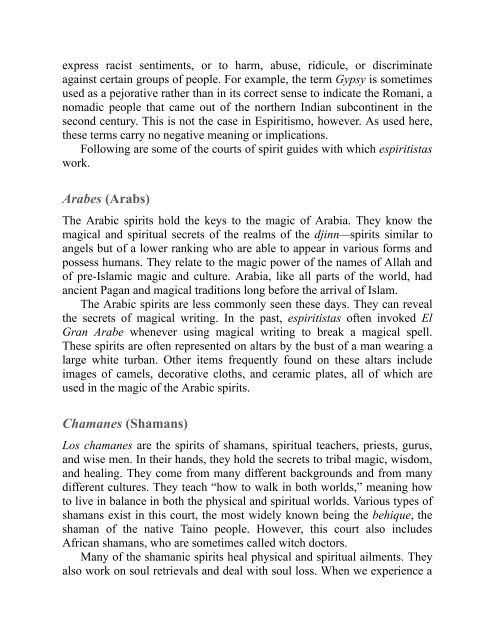You also want an ePaper? Increase the reach of your titles
YUMPU automatically turns print PDFs into web optimized ePapers that Google loves.
express racist sentiments, or to harm, abuse, ridicule, or discriminate<br />
against certain groups of people. For example, the term Gypsy is sometimes<br />
used as a pejorative rather than in its correct sense to indicate the Romani, a<br />
nomadic people that came out of the northern Indian subcontinent in the<br />
second century. This is not the case in <strong>Espiritismo</strong>, however. As used here,<br />
these terms carry no negative meaning or implications.<br />
Following are some of the courts of spirit guides with which espiritistas<br />
work.<br />
Arabes (Arabs)<br />
The Arabic spirits hold the keys to the magic of Arabia. They know the<br />
magical and spiritual secrets of the realms of the djinn—spirits similar to<br />
angels but of a lower ranking who are able to appear in various forms and<br />
possess humans. They relate to the magic power of the names of Allah and<br />
of pre-Islamic magic and culture. Arabia, like all parts of the world, had<br />
ancient Pagan and magical traditions long before the arrival of Islam.<br />
The Arabic spirits are less commonly seen these days. They can reveal<br />
the secrets of magical writing. In the past, espiritistas often invoked El<br />
Gran Arabe whenever using magical writing to break a magical spell.<br />
These spirits are often represented on altars by the bust of a man wearing a<br />
large white turban. Other items frequently found on these altars include<br />
images of camels, decorative cloths, and ceramic plates, all of which are<br />
used in the magic of the Arabic spirits.<br />
Chamanes (Shamans)<br />
Los chamanes are the spirits of shamans, spiritual teachers, priests, gurus,<br />
and wise men. In their hands, they hold the secrets to tribal magic, wisdom,<br />
and healing. They come from many different backgrounds and from many<br />
different cultures. They teach “how to walk in both worlds,” meaning how<br />
to live in balance in both the physical and spiritual worlds. Various types of<br />
shamans exist in this court, the most widely known being the behique, the<br />
shaman of the native Taino people. However, this court also includes<br />
African shamans, who are sometimes called witch doctors.<br />
Many of the shamanic spirits heal physical and spiritual ailments. They<br />
also work on soul retrievals and deal with soul loss. When we experience a


















